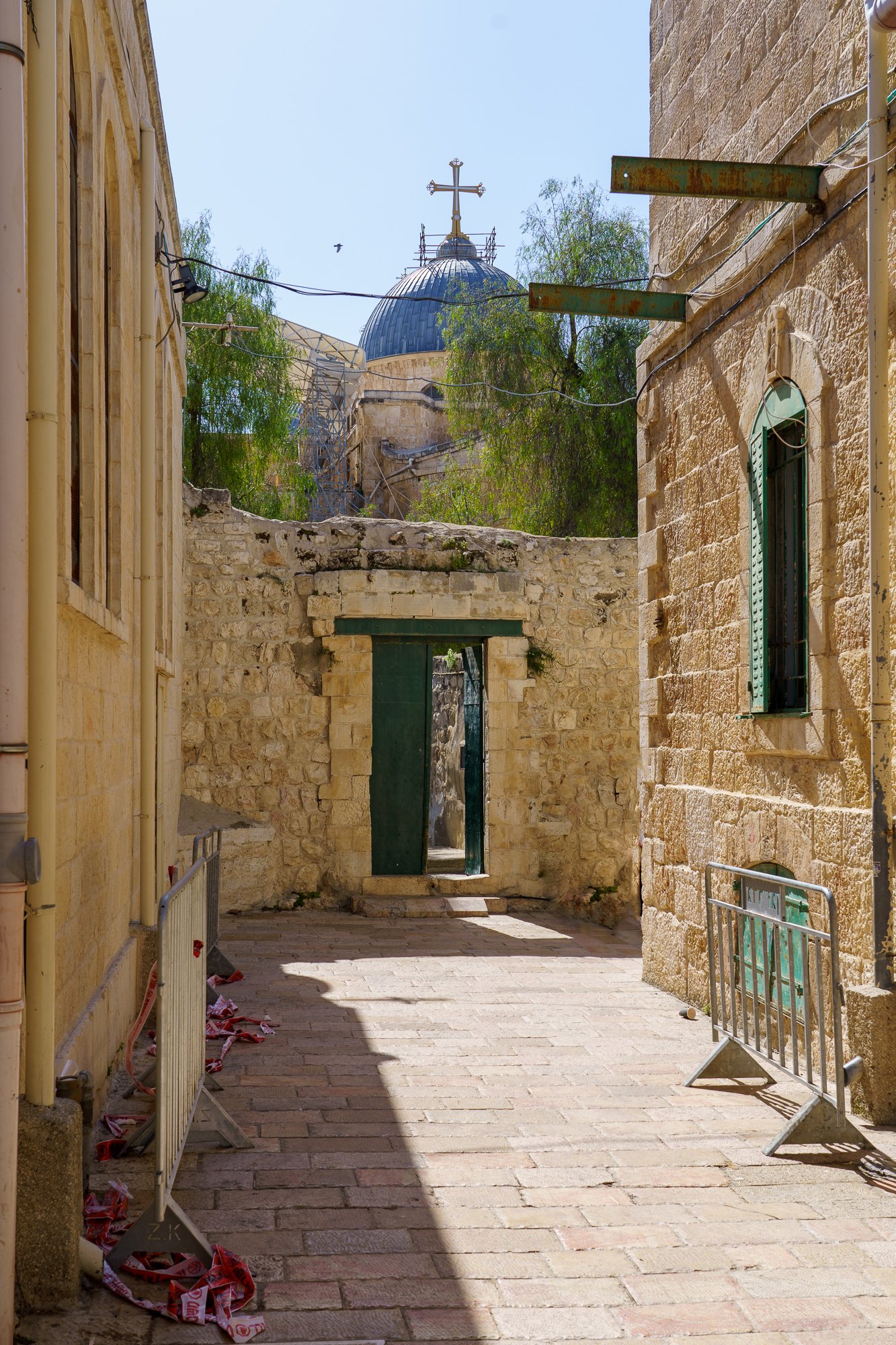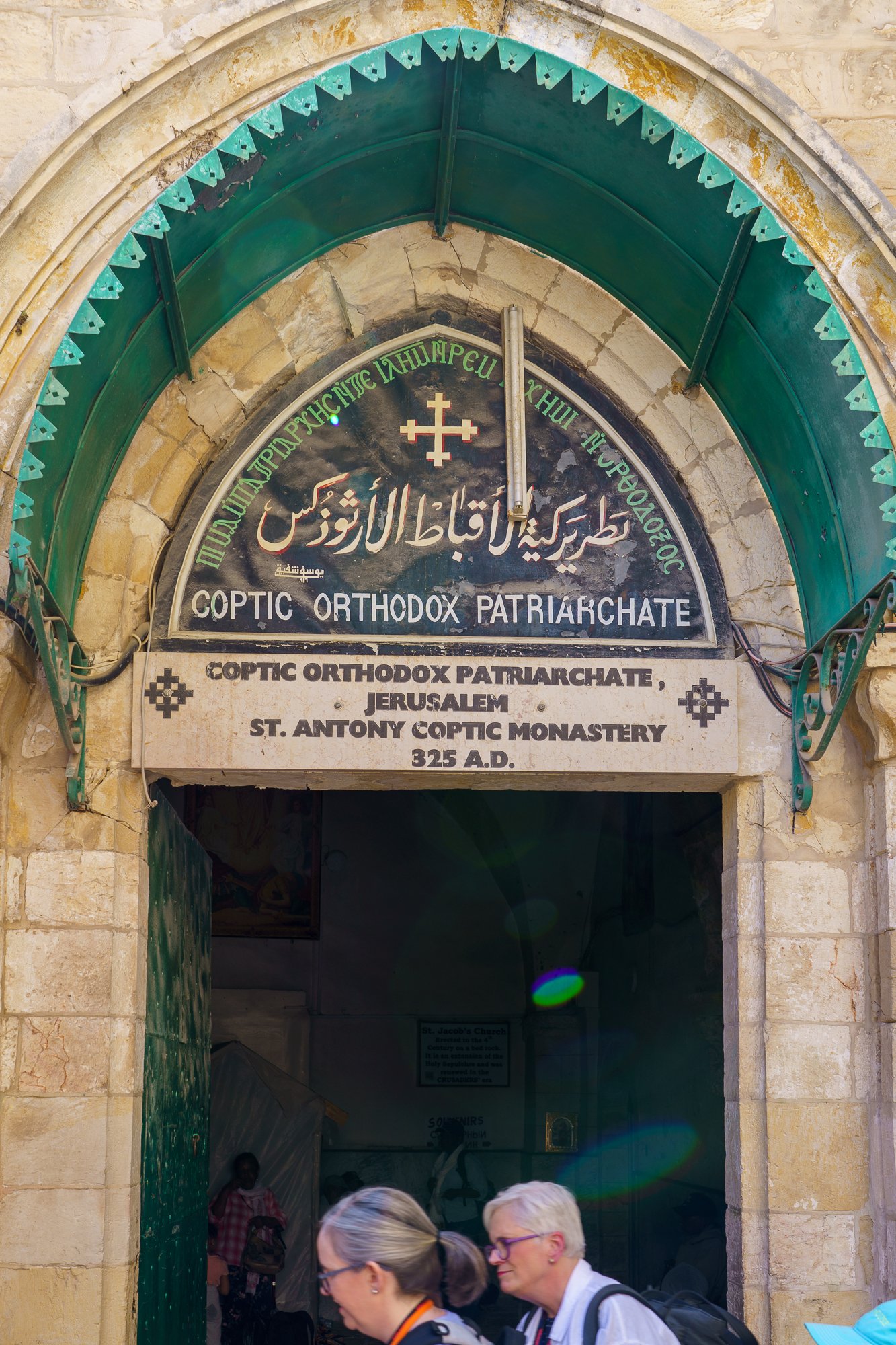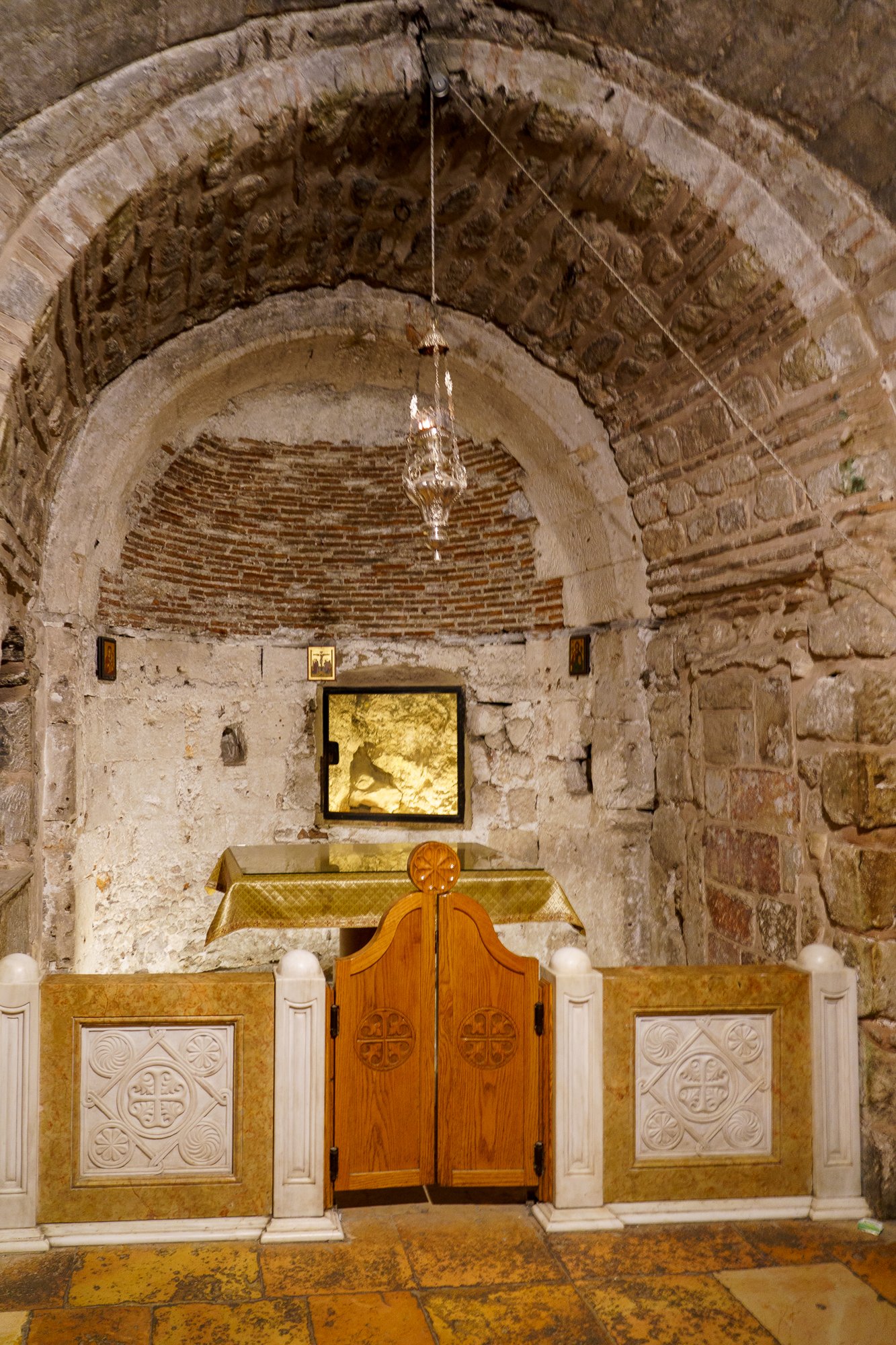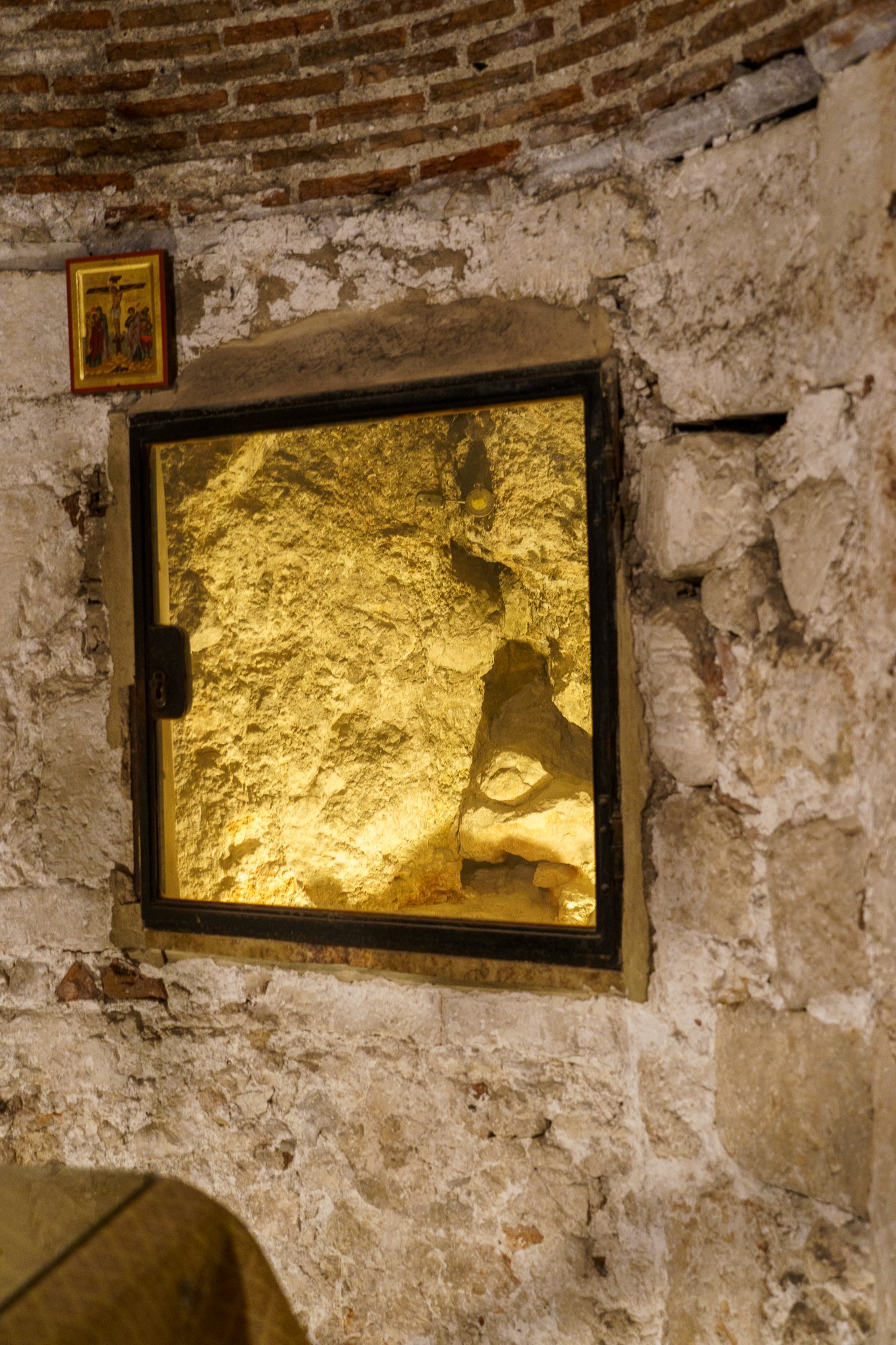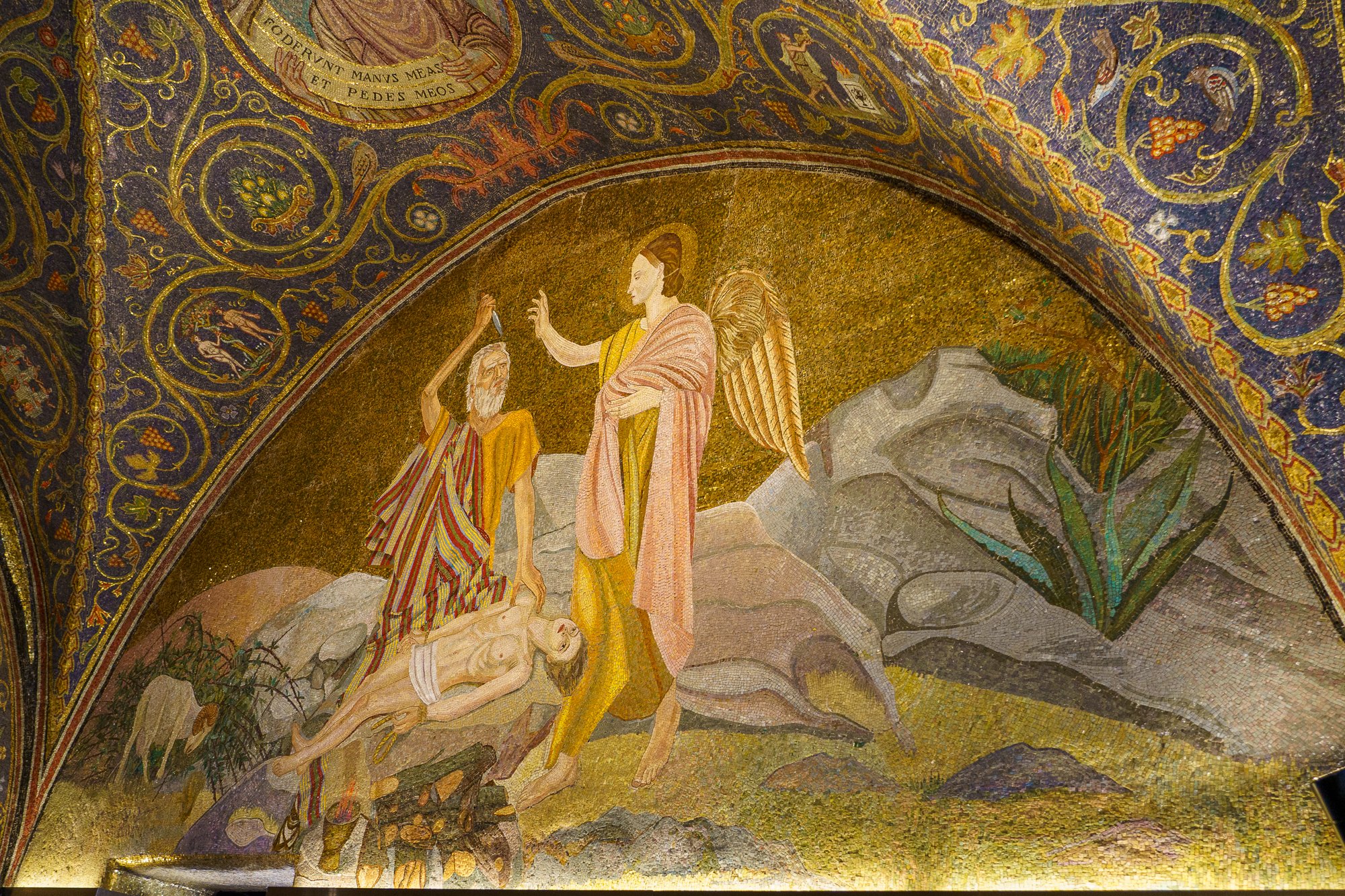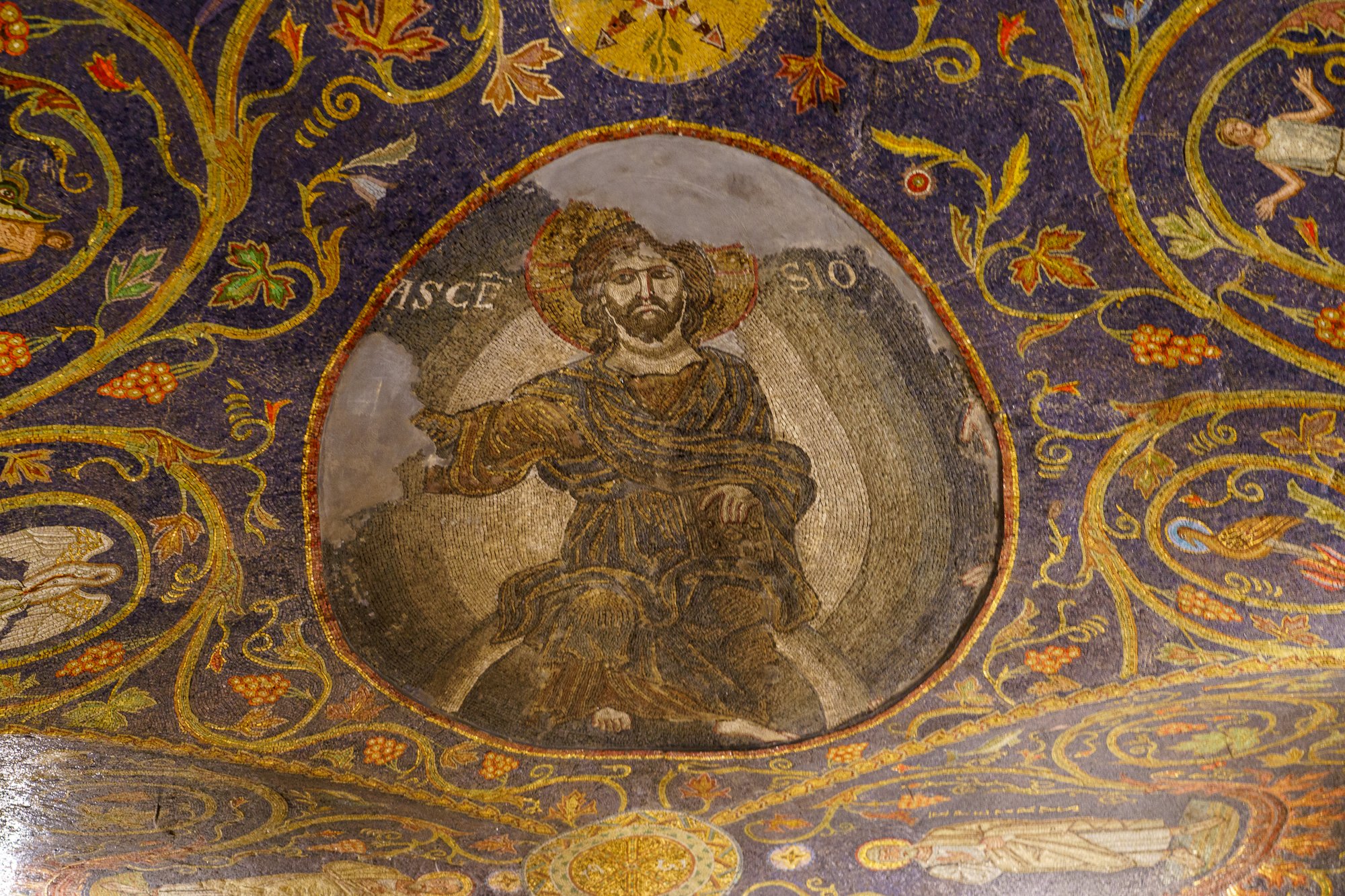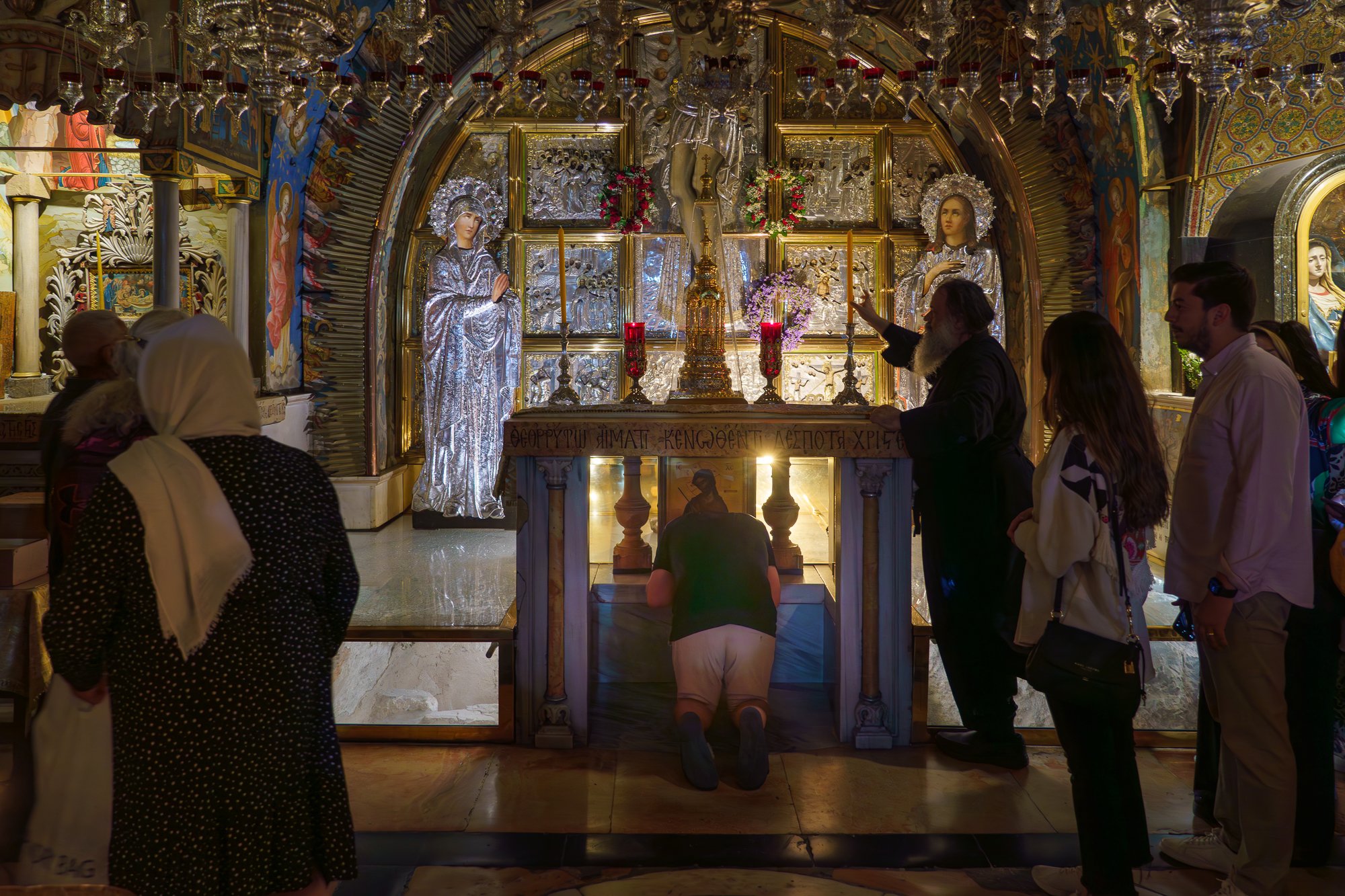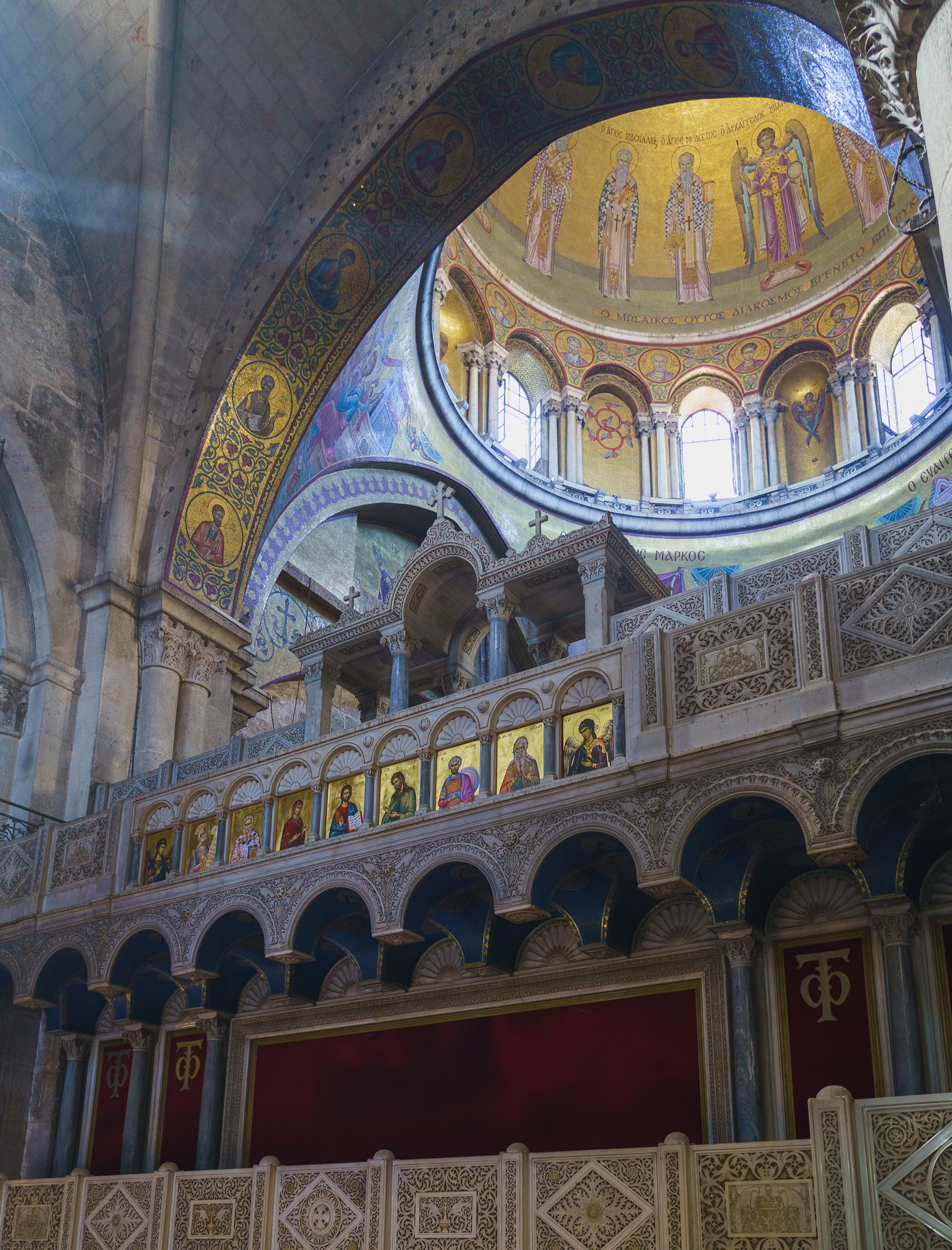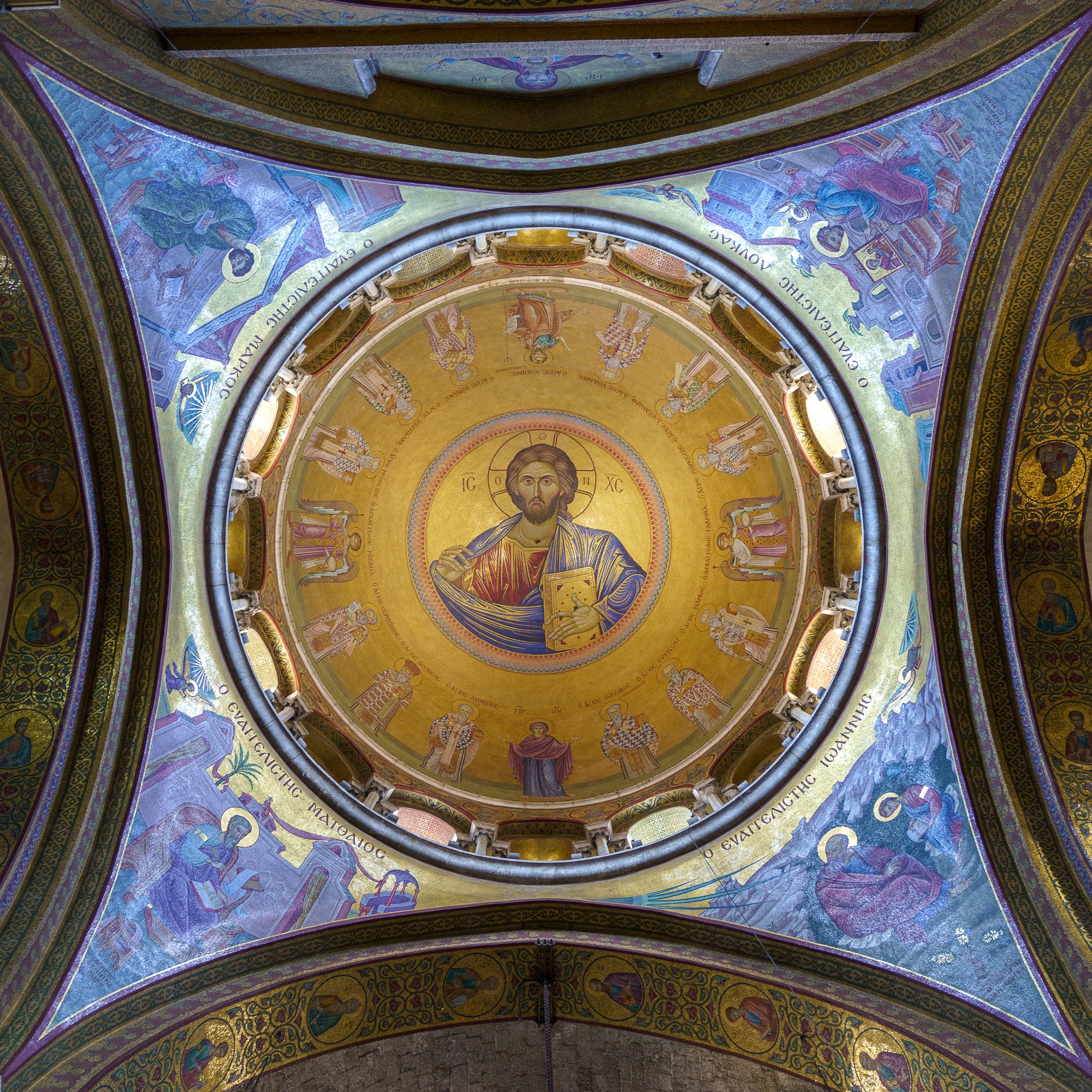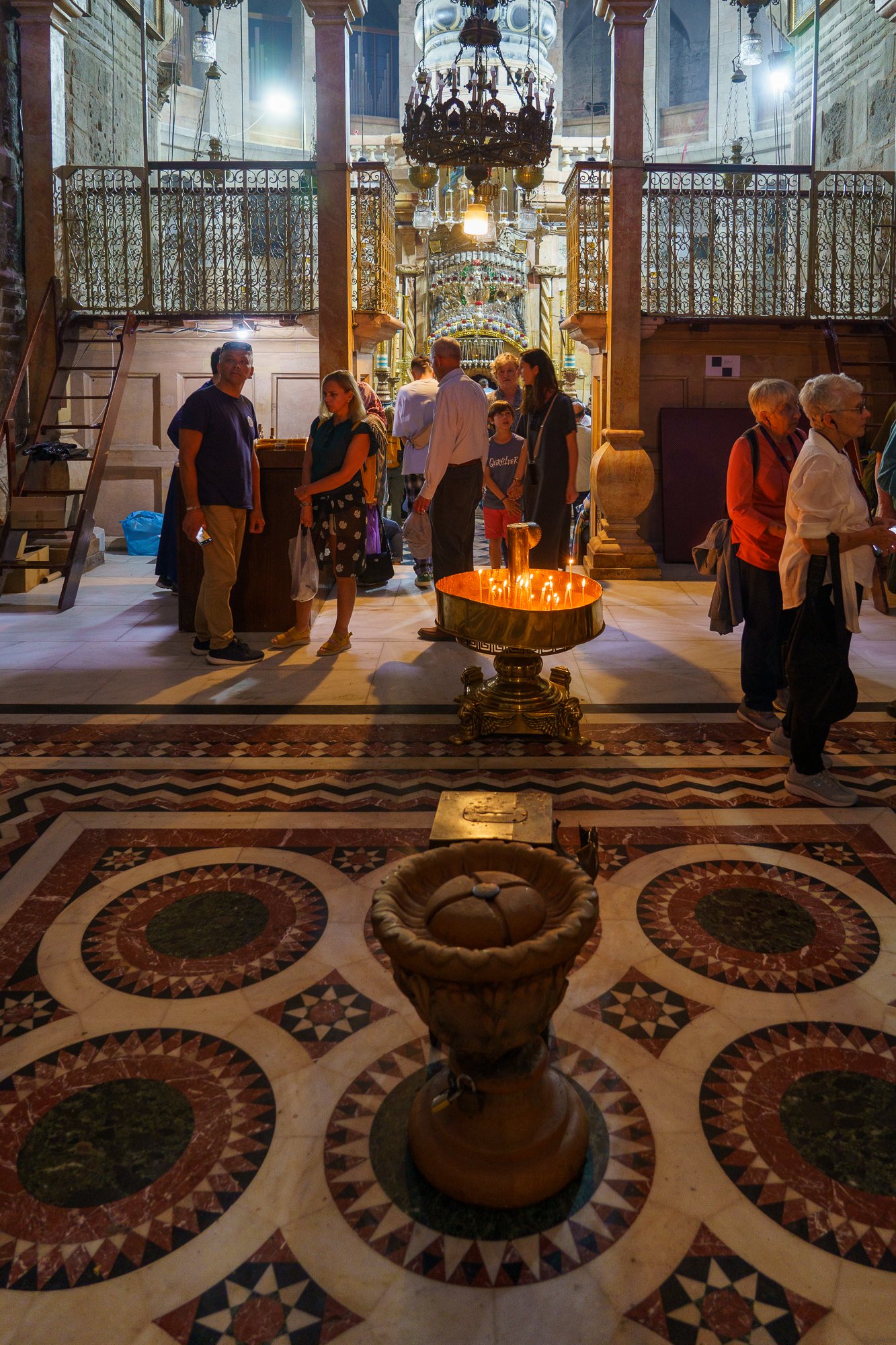We have our first official pilgrimage visits today! The bed was harder than I would have looked, but it turns out that’s exactly what my back wanted. I was stiff, but fully mobile when I woke up and moving around during the day only made things easier.
The agenda called for an archeological orientation discussion followed by a visit to the Mount of Olives to get an overview. We will then follow the time-honored pilgrim tradition of visiting the Church of the Holy Sepulchre for devotions at the site of the Crucifixion, Resurrection, and discovery of the Cross.
I woke up with some congestion and a drippy throat so I took a COVID test. Negative. Phew! We joined the early morning Eucharist in a chapel of the Cathedral and then went to the Guest House for breakfast. The Middle Eastern breakfast is heavy on cheeses, hummus, vegetables, and some fruit with some hard boiled eggs for those of us who crave a heavier dose of protein.
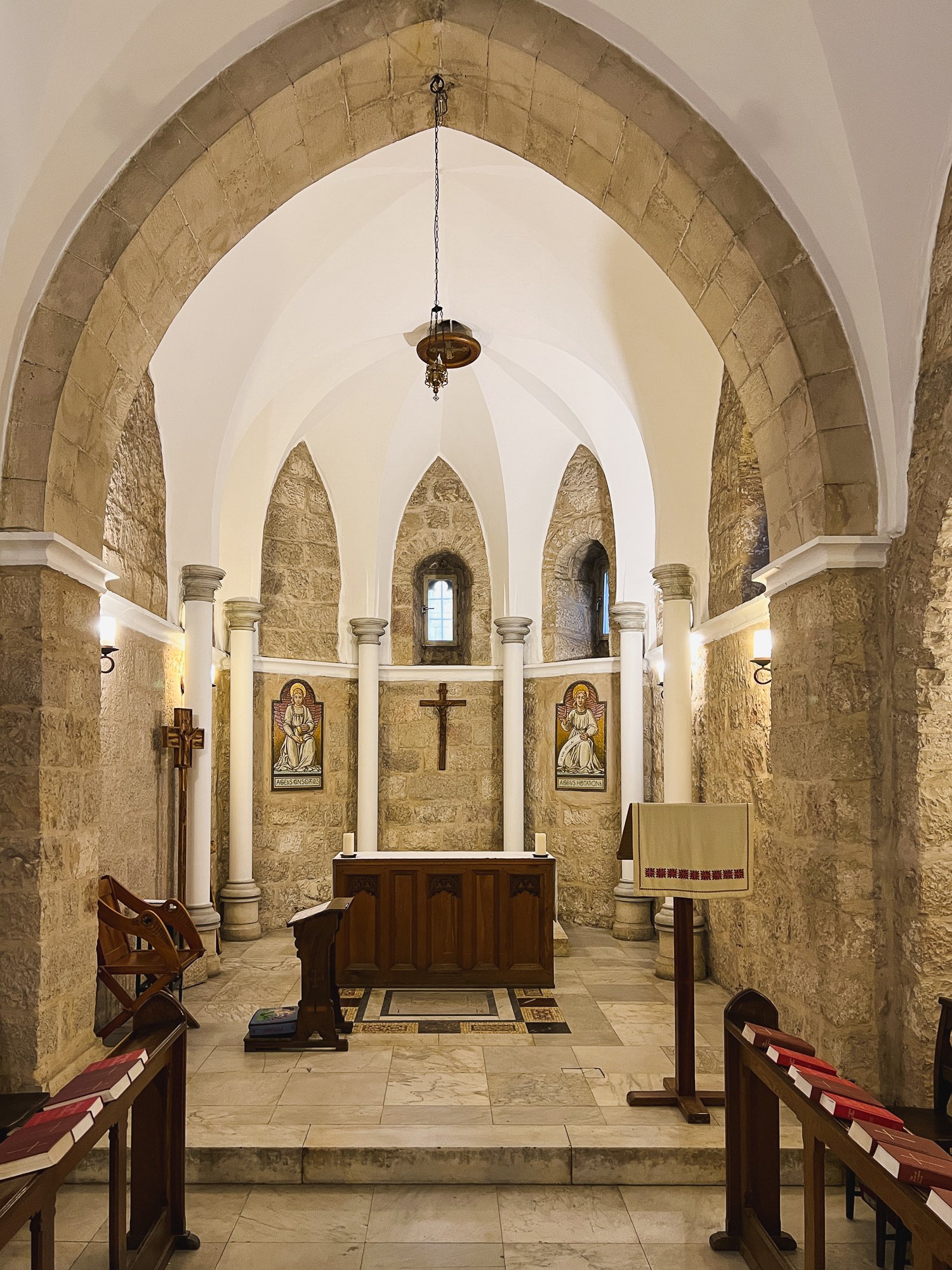
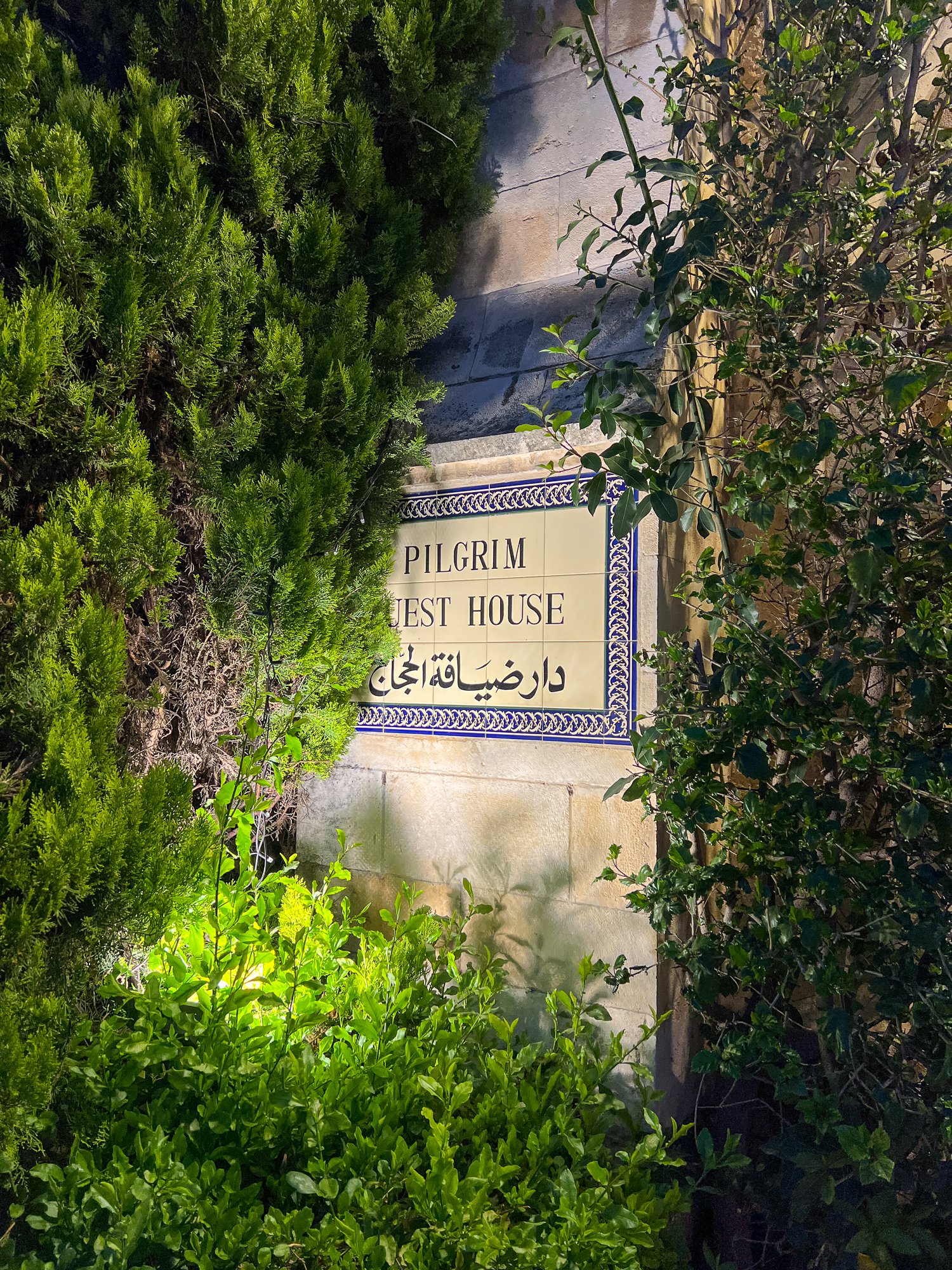

The Cathedral chapel where we held our daily services, Armenian tile signage for the Guest House where we had our meals and evening libations in the garden, and the campus at sunrise.
After breakfast, we took our group photo.
The archeological presentation helped us understand what sites we would be seeing and the geography of Jerusalem itself. May pilgrims are confused by the site of the crucifixion and burial being inside the current walls of the Old City since the Gospels clearly state that Jesus was crucified and buried outside the walls. It turns out that the boundaries of ancient Jerusalem have changed over the millennia (not surprising). The current walled boundaries date to the 1500s and have the city on two different hilltops with a valley between them. In Jesus day, the city was down in a valley (now outside the walls) rising up to the current Al Aqsa Mosque compound, which was the Temple Mount. The location of the Church of the Holy Sepulchre today was a quarry outside the walls where crucifixions were held. When limestone was quarried, they would only take the good stuff leaving hills and columns behind of stone they did not want. It was on top of one of these mounds that Jesus was crucified with the two thieves. This gives even more meaning to “The same stone which the builders rejected has become the chief cornerstone.” Jesus was crucified atop rejected stone.
We took a bus to the top of the Mount of Olives and met Ali, our bus driver for the duration. Super nice guy! The Mount of Olives is just outside the Holy City with the Kidron Valley separating them. This is where Jesus taught when he was in Jerusalem. It is also an important burial site for both Jews and Muslims who believe that the first people to be raised from the dead are those buried on the Mount of Olives. It is the most sought after burial real estate in the world!

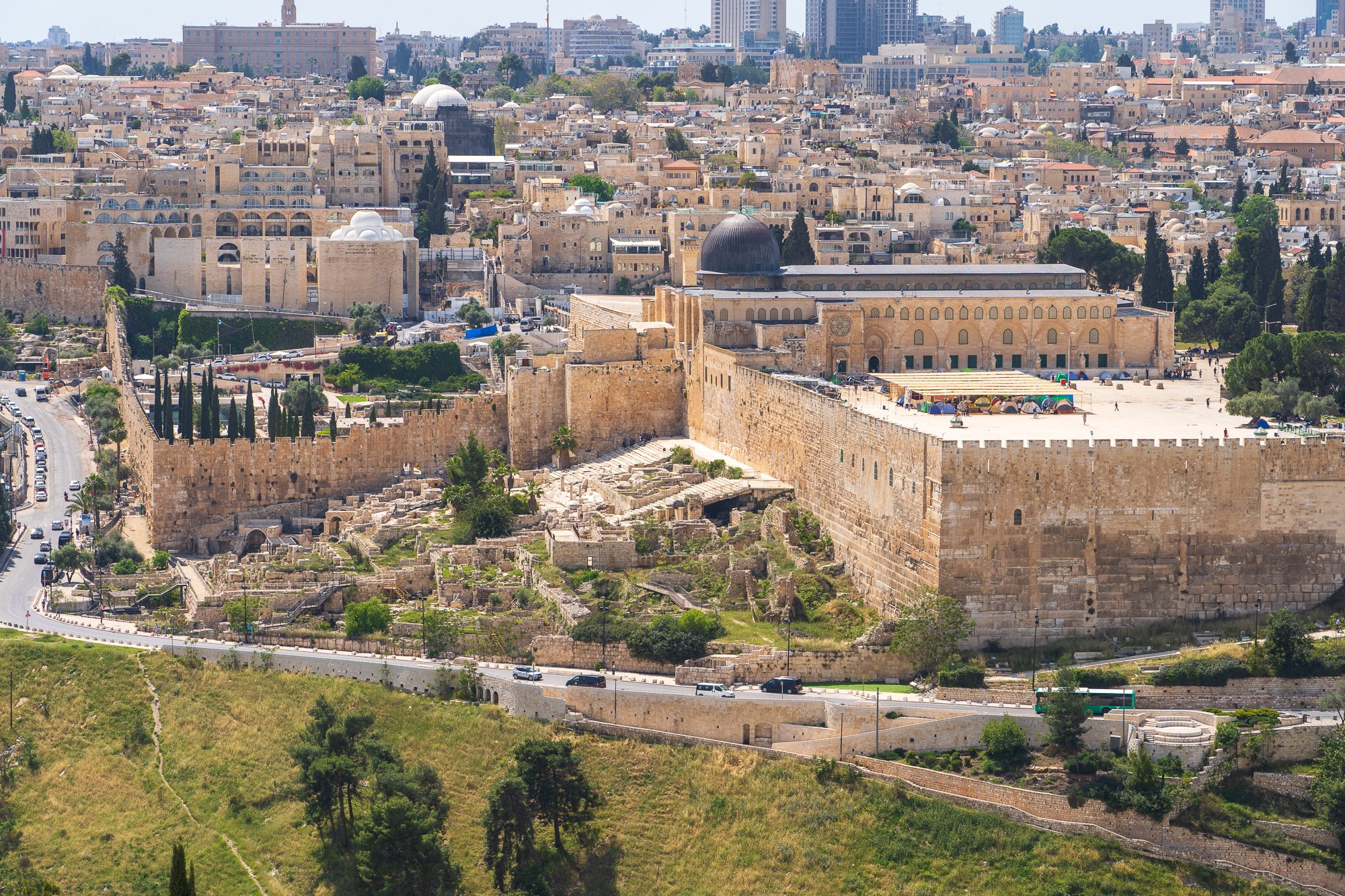
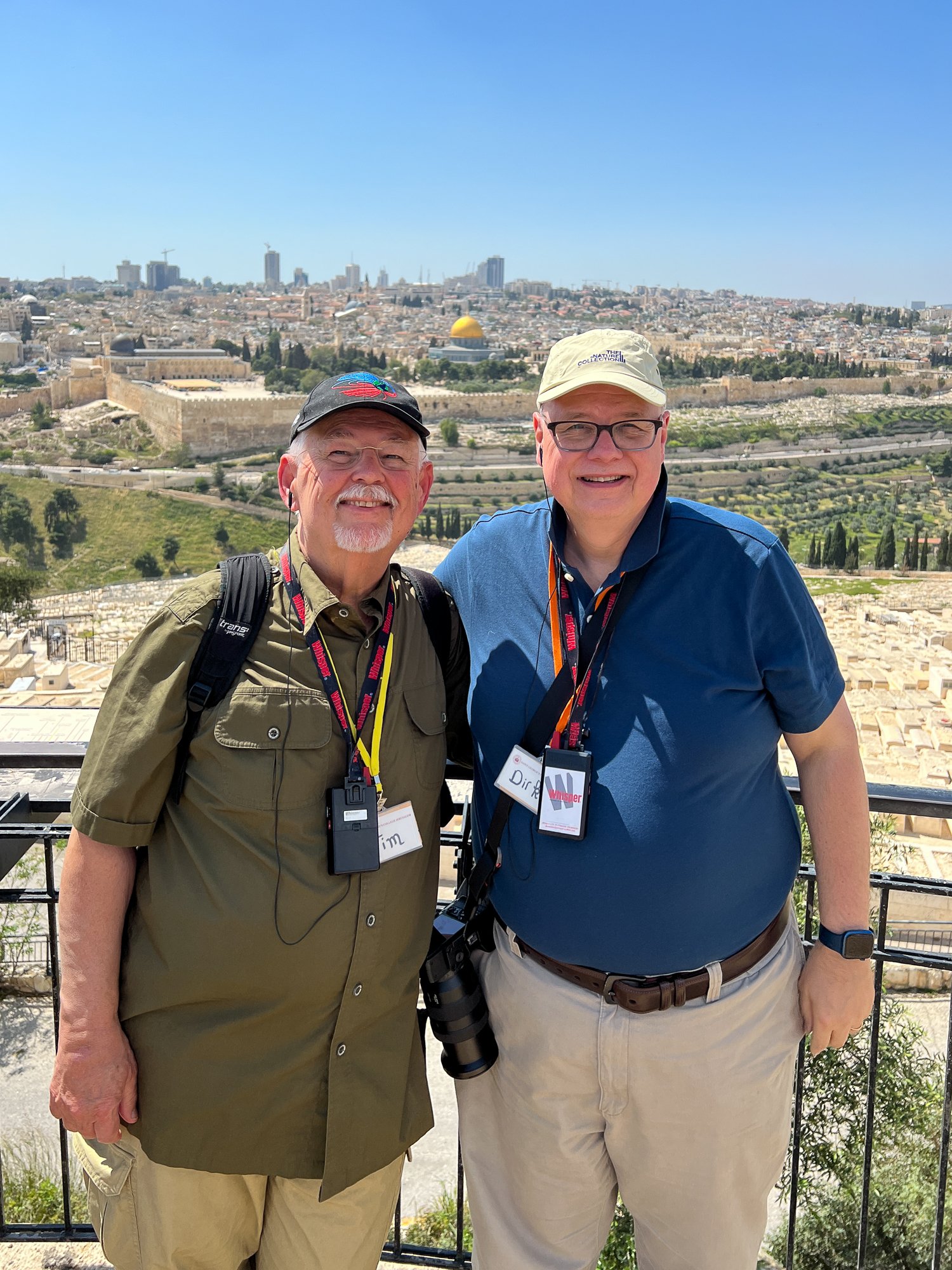

The view from the mountain shows how prominent the Temple would have been in Jesus’ day - it was at least twice the height of the Dome of the Rock. That plaza it sits on forms the old Temple precincts. The steps you see rising from the bottom left were the main entrance to the Temple precincts and where Jesus would have entered. The two gray domes in the background are the Church of the Holy Sepulchre, and modern day West Jerusalem rises behind that.
The Mount of Olives is also the site of the Ascension, the Eleona (church on the site where Jesus gave his apocalyptic discourse), the Dominus Flevit, a church built on the site where Jesus wept for Jerusalem, the Garden of Gethsemane, and the tomb of Mary the Mother of Jesus. The is also an Orthodox Monastery dedicated to to Saint Mary Magdalene. No one knows anymore what spot it was commemorating. That is lost to history, but its dedication to the Apostle of the Apostles (Mary Magdalene was the first to whom the risen Christ appeared, and he commissioned her to tell the others) lives on. It is also where Prince Phillip’s mother (and Orthodox nun) was buried.
I want to note that we speak of mountains and valleys as if things are far apart. They are not. One can walk from the top of the Mount of Olive to the heart of the Old City in 45 minutes to an hour.
After getting our overview, we took the bus back down the mountain to the Damascus gate, which is the most direct entry to for the back entrance to the Holy Sepulchre. This gate is in the Muslim Quarter and the shops are mostly ordinary businesses catering to local residents. We had come in this way on Saturday.
Rodney, our guide took us through the passageways to the rear entrance of the Church. It is quieter, and lets us see the Coptic chapels before we emerge in the main courtyard. It is also the former main entrance when the Church was much larger during the Byzantine period before it was destroyed by a Caliph shortly before the Crusader period, so we are being taken in from the older to the newer sections.
This is Tuesday of Orthodox Easter week so the crowds are less intense than the previous Easter weekend, but are still plentiful. Rodney guides us around to show us the Chapel of Adam, where tradition says Adam was buried and where he became the first to be raised from the dead with Christ. The chapel is immediately below the site of the Crucifixion and windows in the walls show splits in the stone. Tradition says these were created by the earthquake at the time of the Crucifixion and allowed by the blood of Christ to trickle down into Adams grave to revive him again. “By his blood, we are healed.”
We were then taken up to the Latin and Orthodox chapels of Calvary. This is basically one chapel with two naves and two altars, one under the jurisdiction of the Roman Catholic and one under the jurisdiction of the Greek Orthodox. The Roman Altar marks the spot where the body of Jesus was taken down from the cross, while the Orthodox Altar is over the spot of the actual Crucifixion. Again, glass pains let you see the stones beneath.
There is a mosaic on the Latin side showing the near sacrifice of Isaac, which is a fore-shadowing of the Crucifixion (God will provide a sacrifice, and the sacrifice of the son). Some traditions say that Calvary is the spot where the Abraham was spared from offering Isaac. However, most traditions say that Mount Moriah, the site of the encounter, is actually where the Temple stood (and now the Dome of the Rock). The mosaic of Jesus in the ceiling of the Latin chapel is the oldest mosaic, going back to the Crusader period.
While Orthodox altars are normally blocked off from the people by an icon-filled wall called an iconostasis, this Altar remains exposed so the faithful can kneel underneath and reach through a whole to touch the actual stone. We each were given an opportunity to venerate and pray before we moved back downstairs.

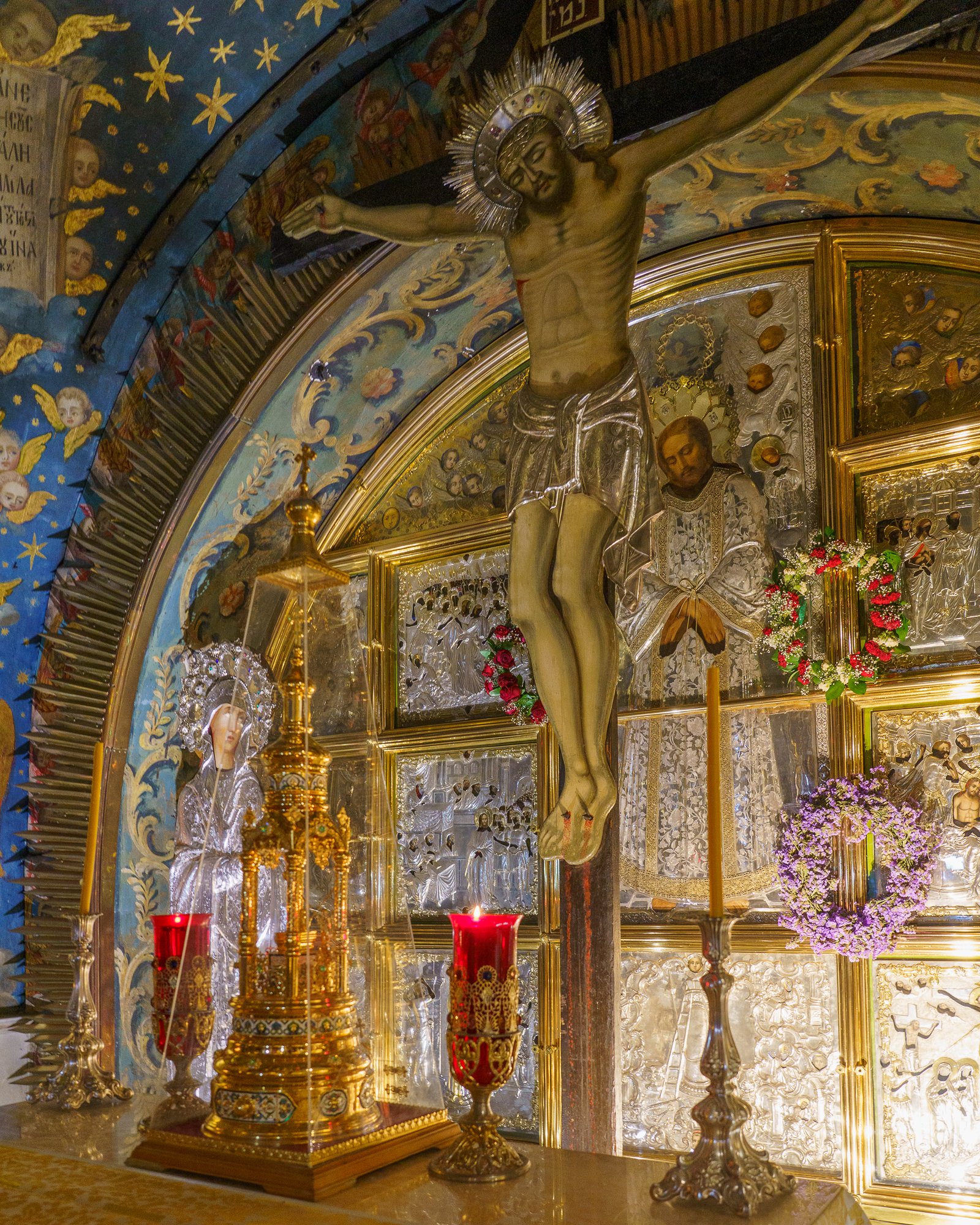
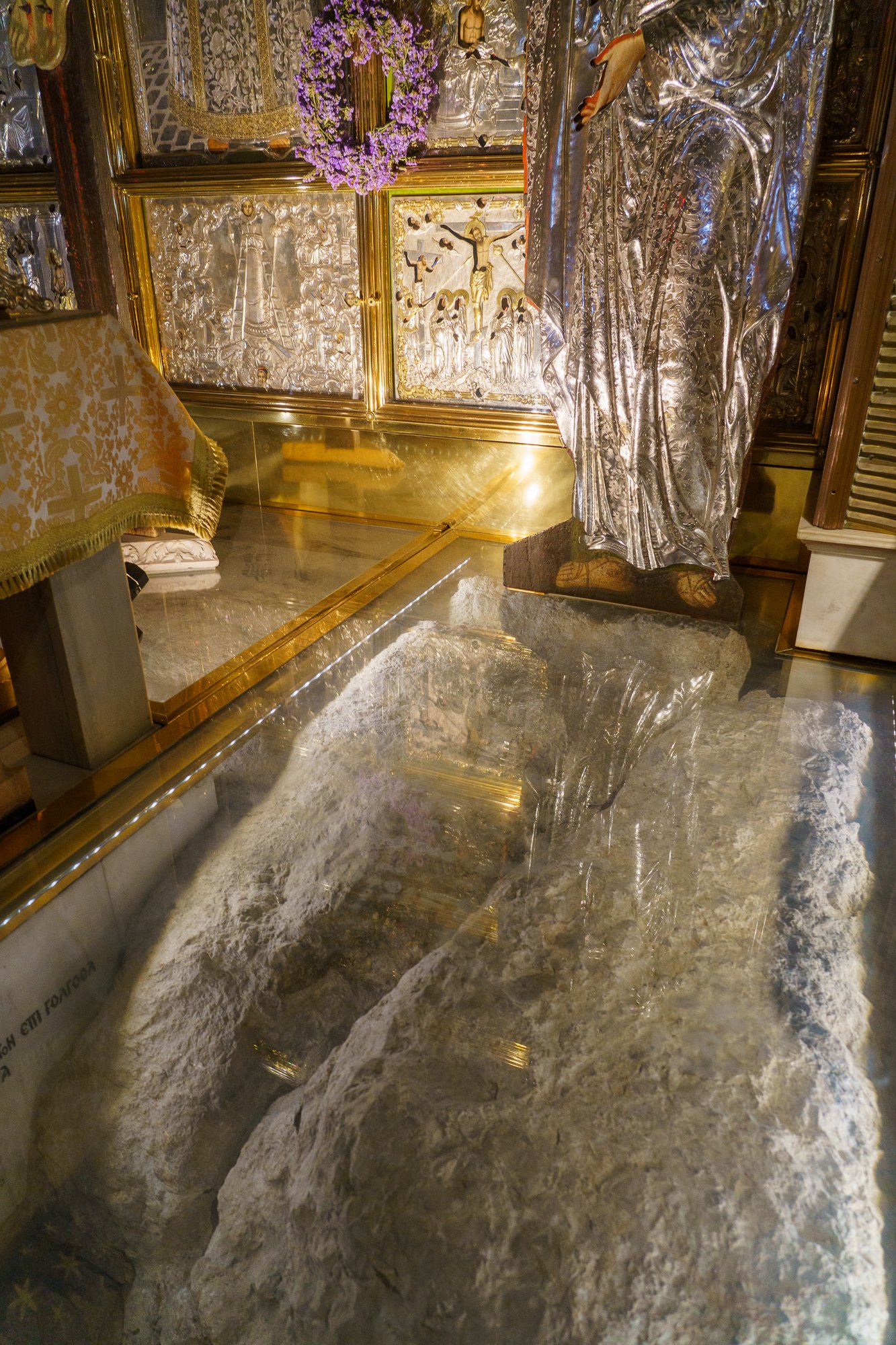
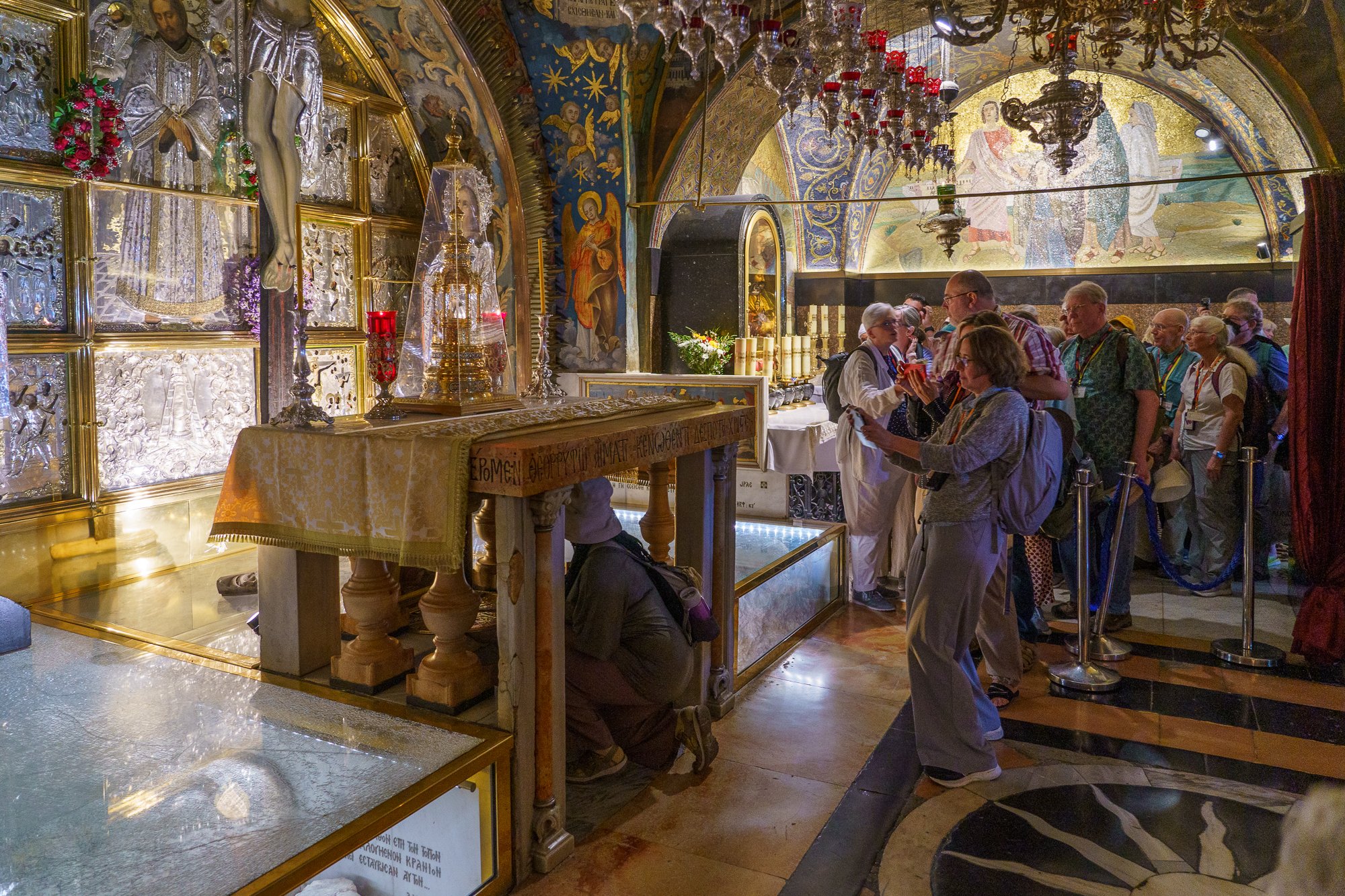
Plenty of time was given for us to pray. As we waited for others, we lit candles and took in the views of the architecture.
The focal point of the church is the Edicule (“Little house”) a stone chapel built around the tomb of Jesus. It is here that the faithful gather at the start and completion of their pilgrimages. In the 19th century, some English protestants questioned the legitimacy of the Holy Sepulchre as the site of the Resurrection. There was some confusion about the location of the city walls since it was now within the walls, but also some anti-ceremonial bias against the rituals of the Latin and Orthodox churches.
British Major-General (a very modern model?) Charles Gordon followed suggestions of others that a nearby escarpment appearing as a skull with an empty ancient tomb was in fact the true burial site of Jesus. European protestants celebrated that discovery as the true site and created a lovely garden park and pilgrimage location. Unfortunately for General Gordon, the tomb was dated to several hundred years before Jesus, which negates the Scriptural witness that Jesus was buried in a new tomb. Even the Garden Tomb site today does not make the claim that it is THE site, only that it “could be.”
Since then, archeologists have found behind the Edicule other tombs dating to the first century which confirm that the site was indeed a burial ground. Archeological evidence confirms there is no reason to doubt that the Holy Sepulchre contains the sites of the crucifixion and resurrection.
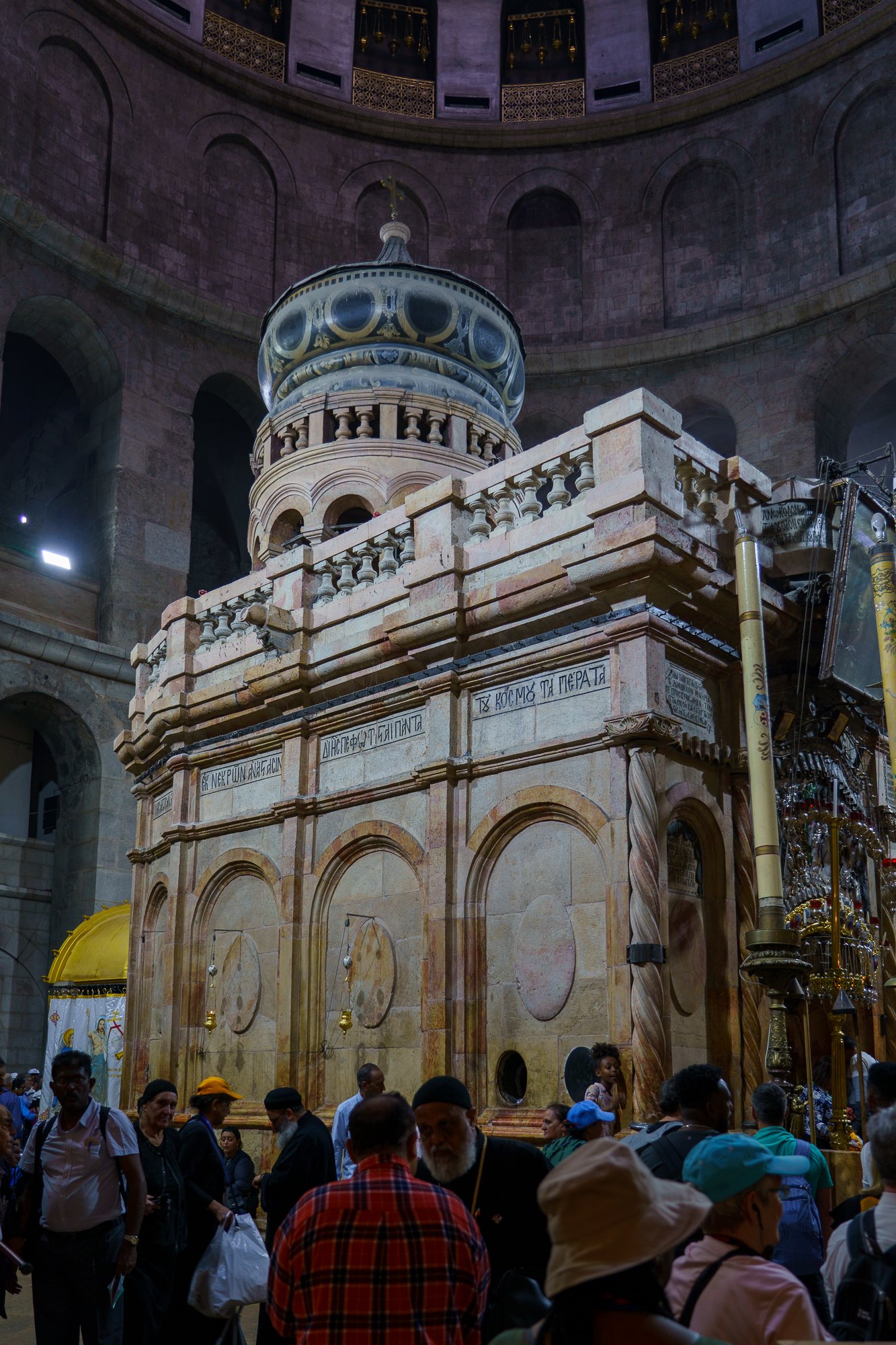

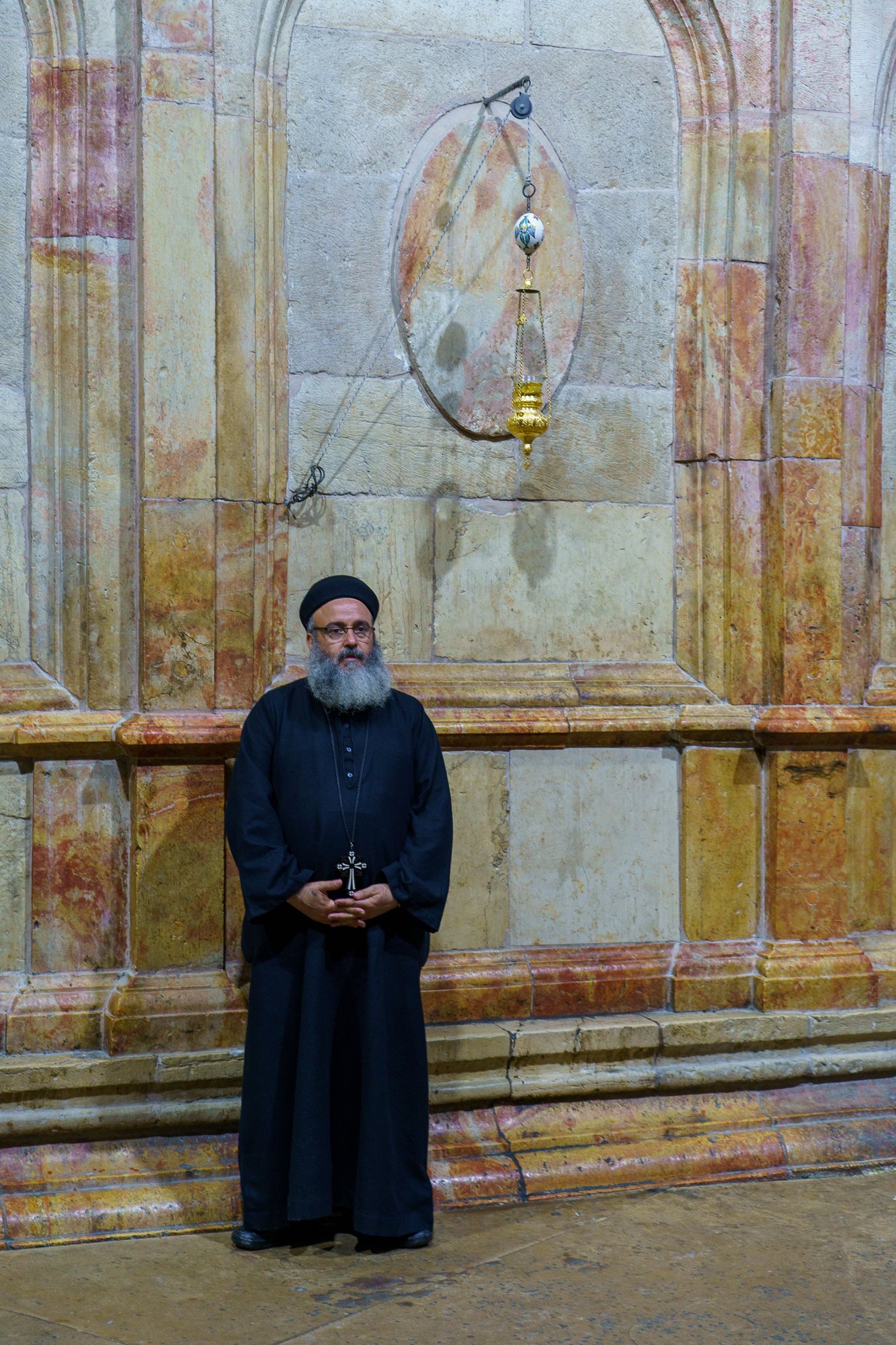
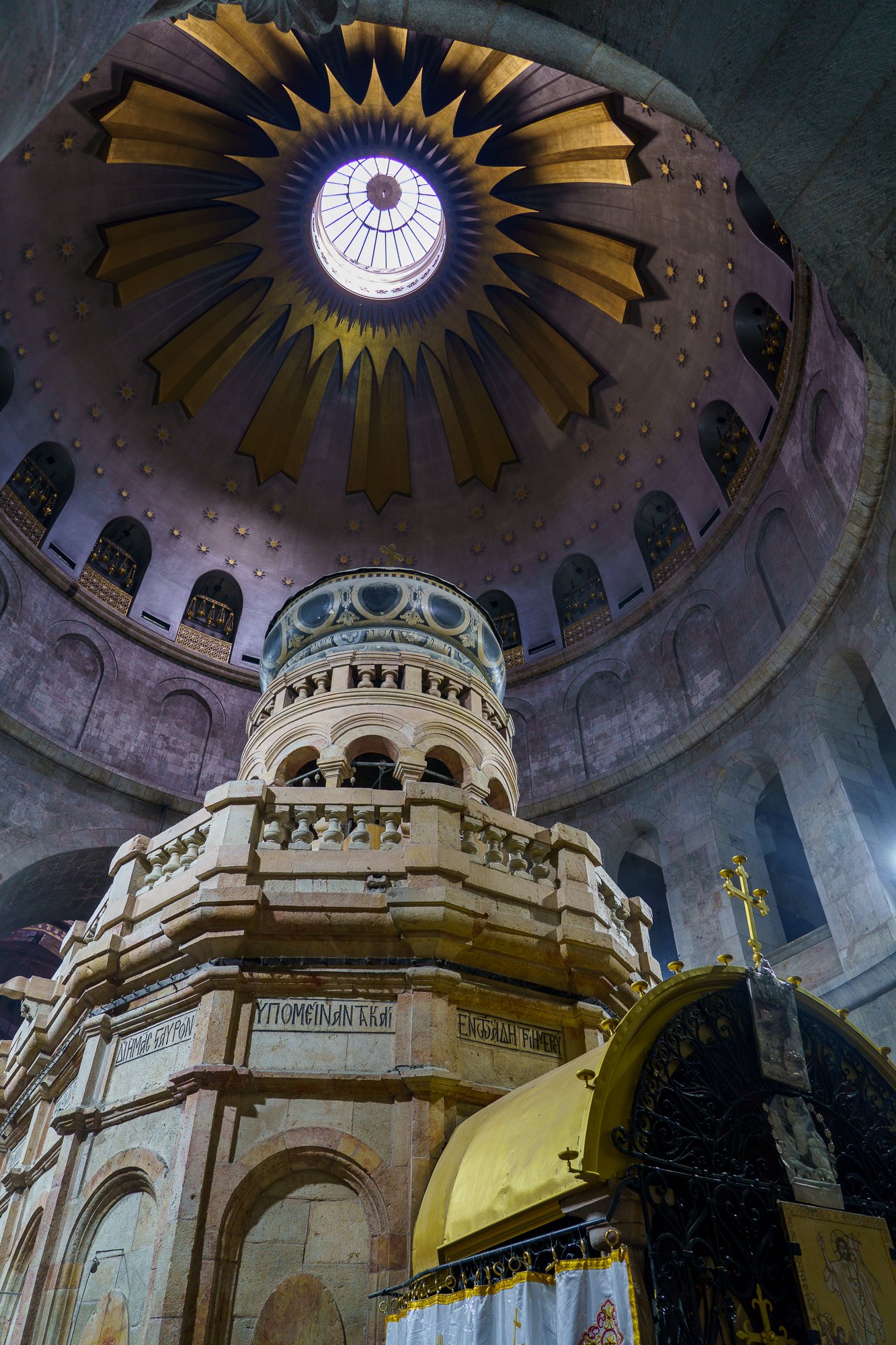
The Edicule opens onto the Catholicon, which is the name for the chapel that is the seat of the Greek Orthodox Patriarch of Jerusalem. It has a gorgeous dome with a mosaic of Christ enthroned flanked by the four Gospel writers. Ini the center underneath the dome is an object called the navel of the world. It is here, tradition says, that creation began. Jerusalem is that place where the world converges and from whence it sprang.
It is this sense of continuous connection with the past that is very powerful in the Holy Land. Churches were built in the 4th century where veneration was already taking place. Pilgrims to this day make the same journeys and engage in the same devotions as those of the ancient past. Ancient graffiti is carved into the stones leading to the various chapels (often crosses), and modern graffiti joins it.
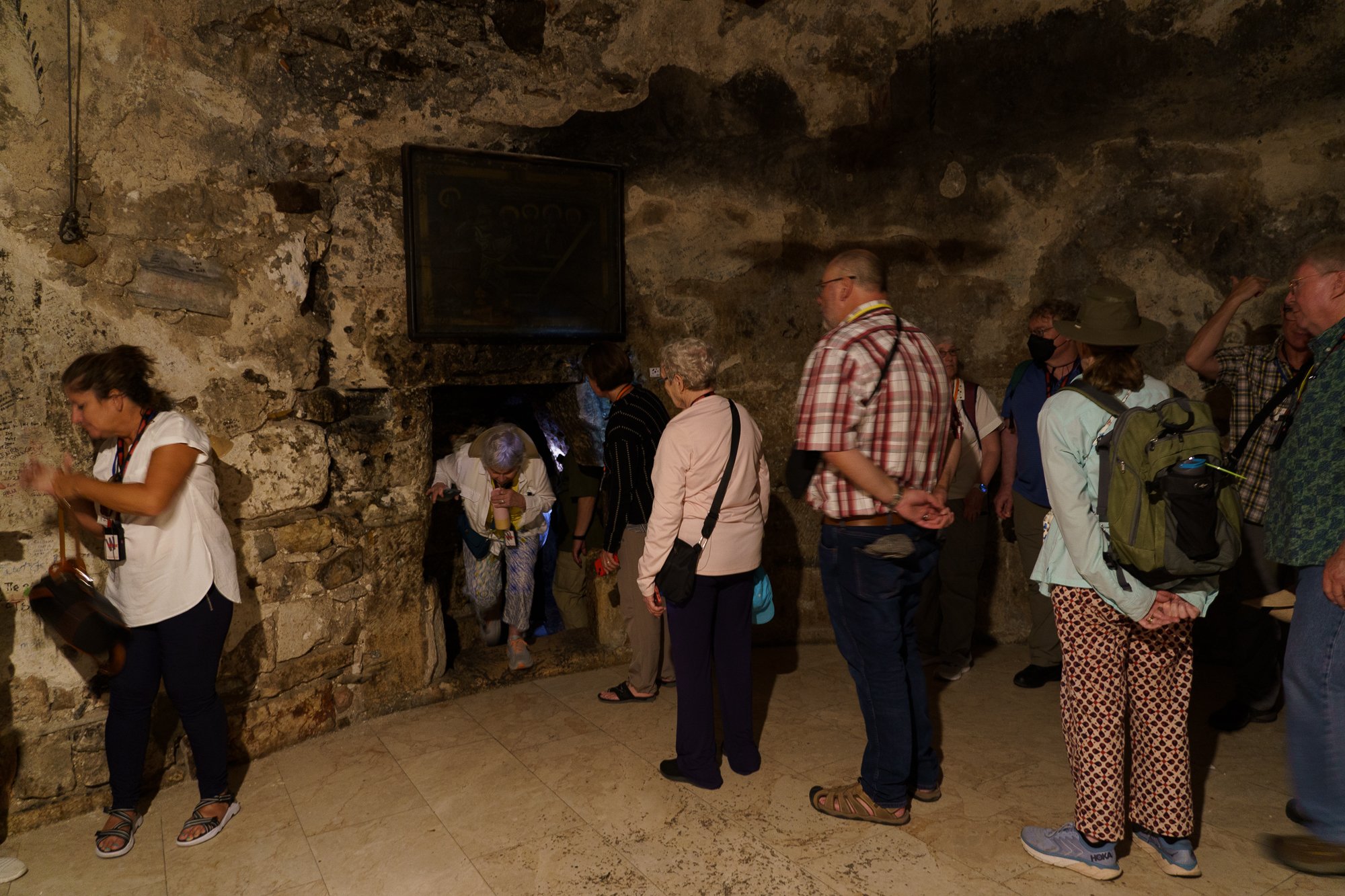
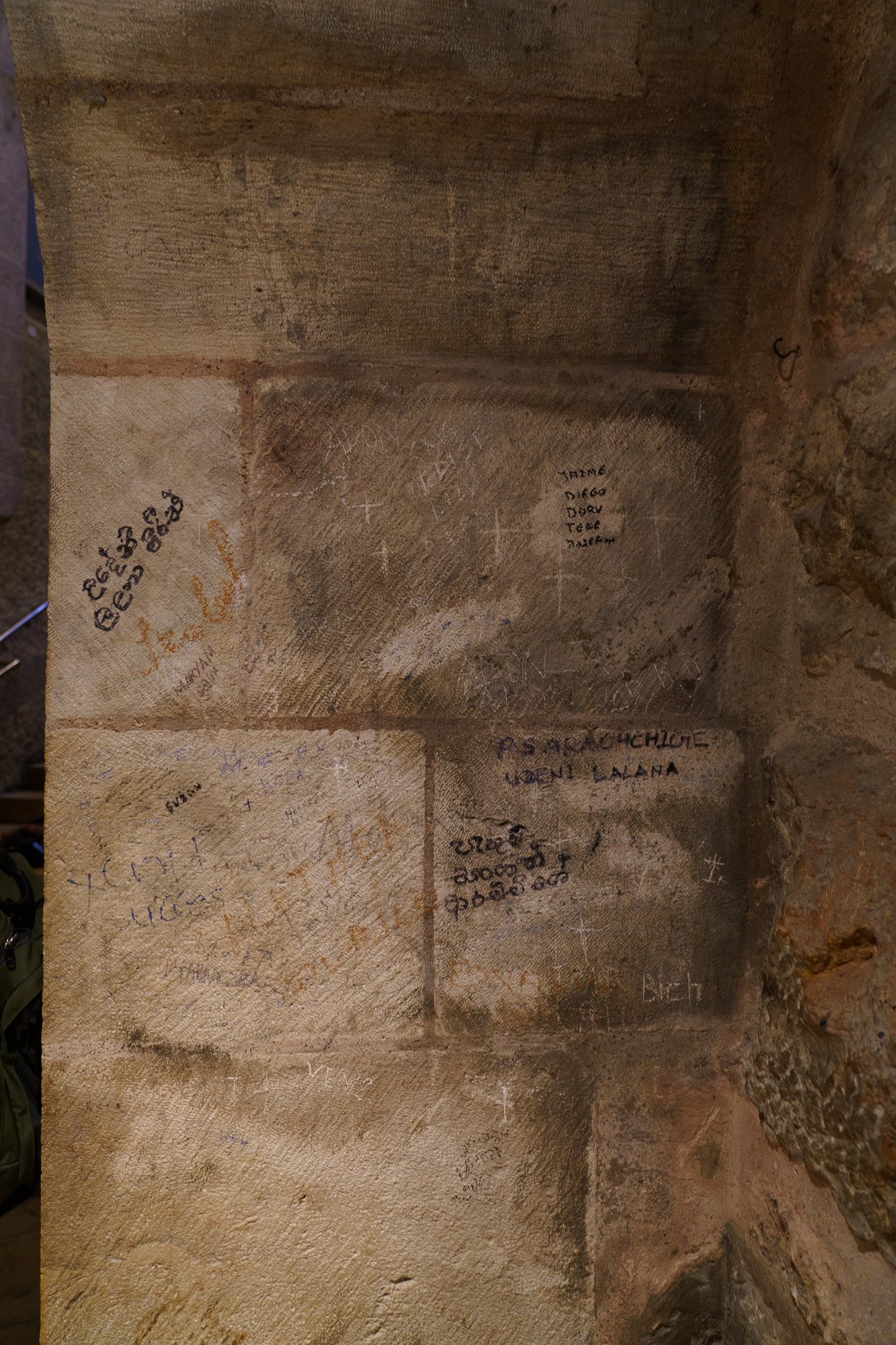
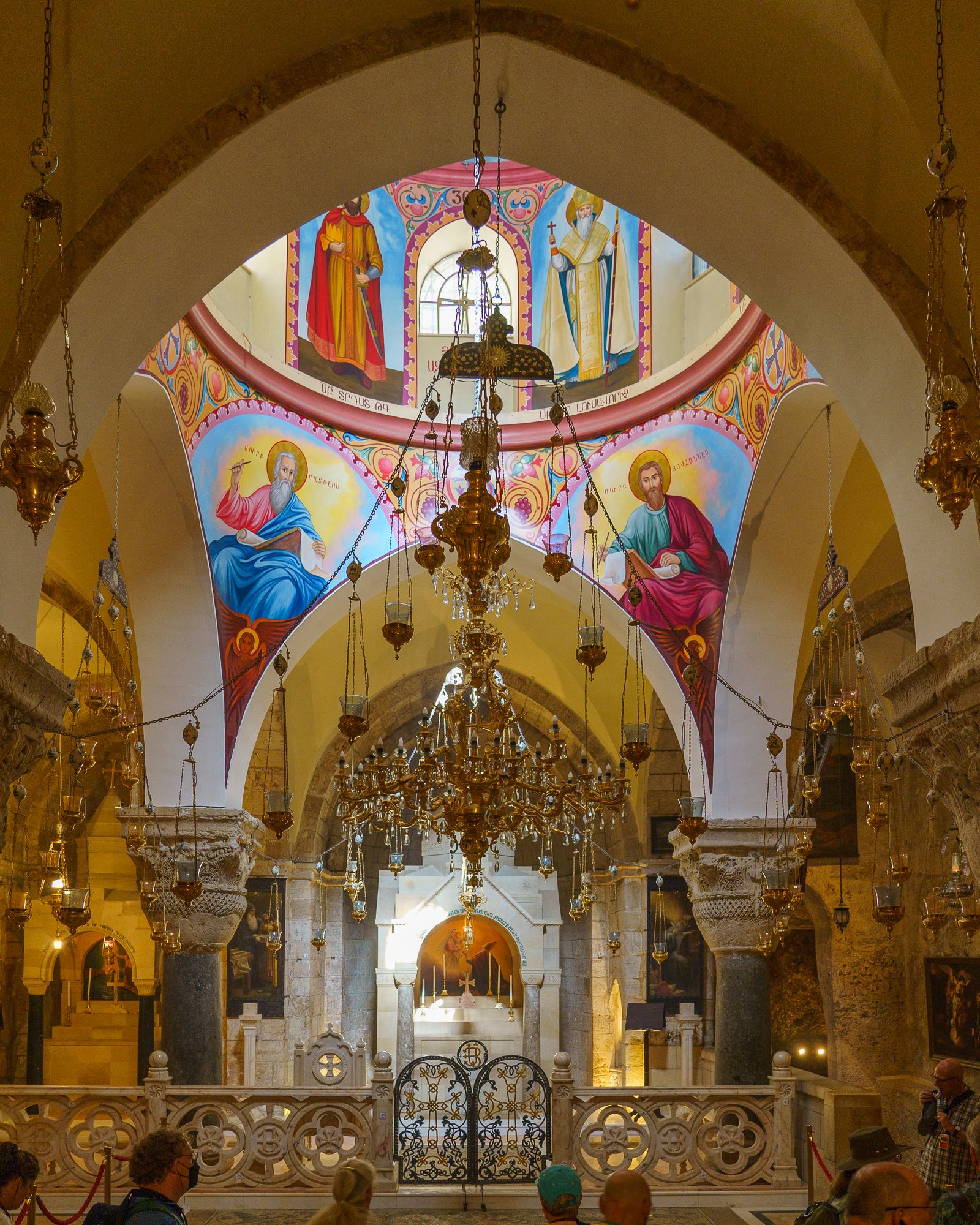
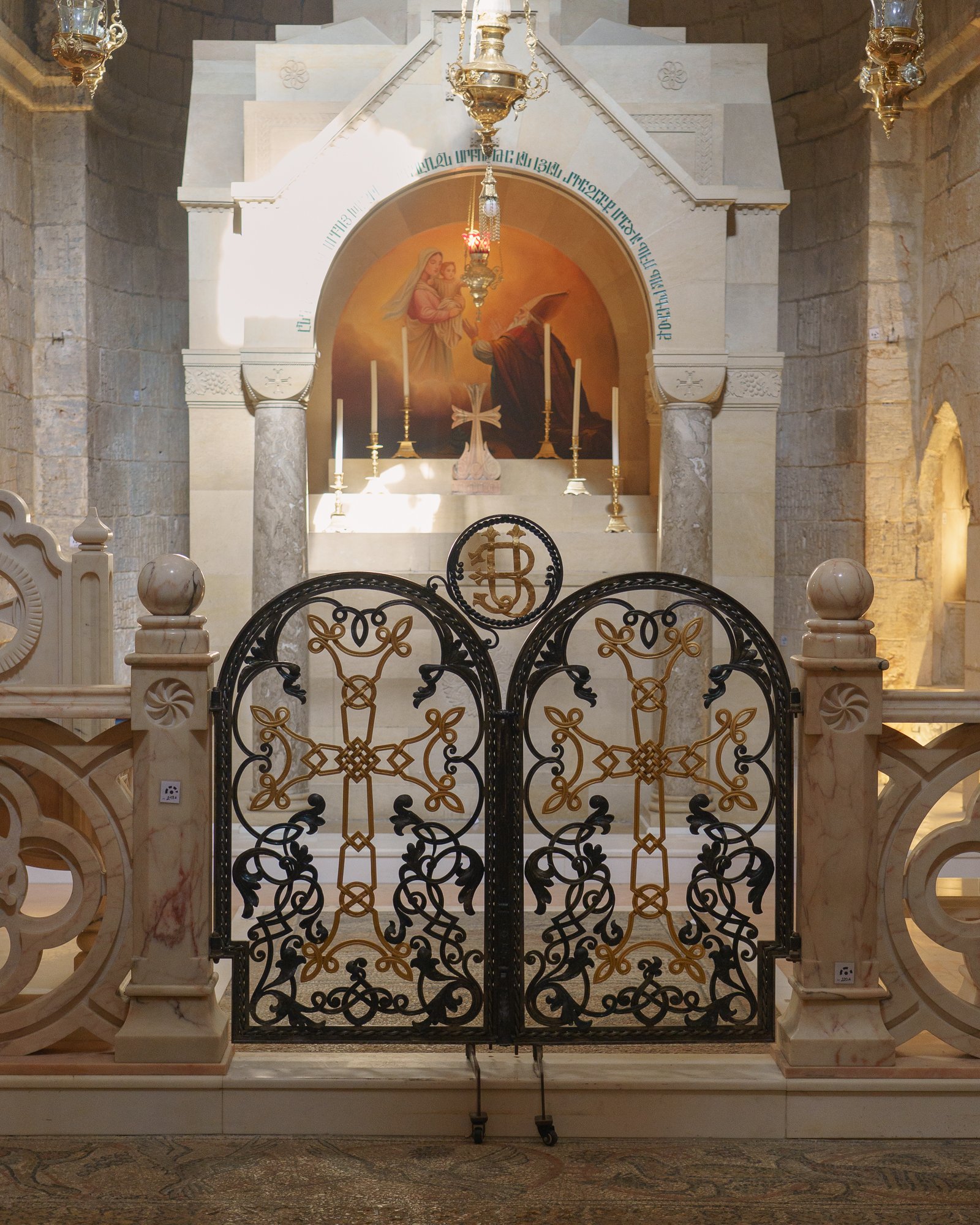
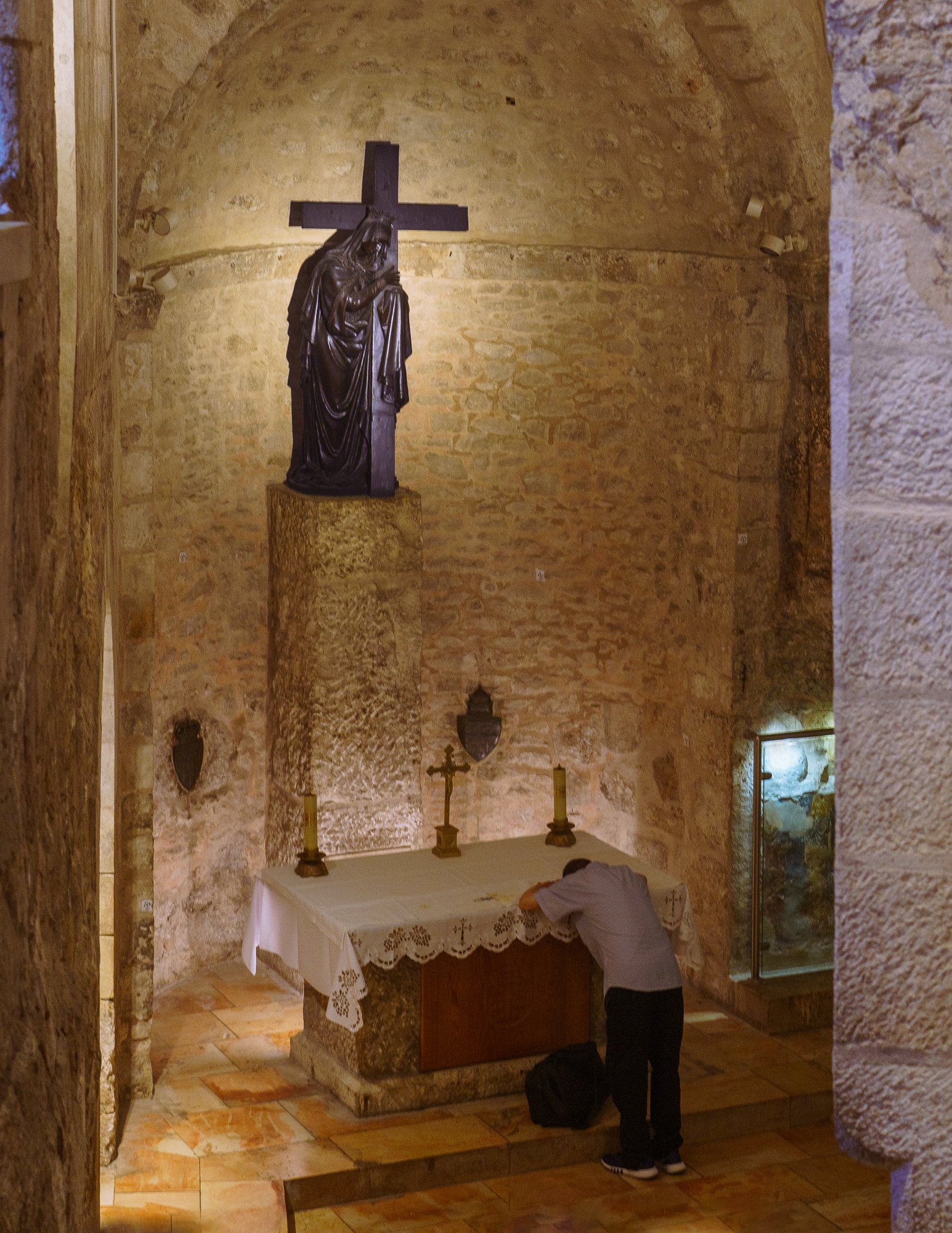
The entrance to other first century tombs found near the tomb of Christ, with some modern pilgrim graffiti joining the ancient pilgrim graffiti! The Chapel of St. Helena sits above the old quarry where the Altar of the Exaltation of the Cross now stands, a favorite spot for prayer for many pilgrims.
I felt the stirrings of a continuous faith come alive for me. From this place, Mary Magdalene discovered the risen Lord. Jesus then sent her to tell the others that he had risen from the dead and would meet them later. After they met the risen Christ, they then told others who told others who told others, until my parents learned of the faith and handed it one to me. This is a true origin story, not just for me, but for each believer. All that we know, believe, and venerate comes from this place.
After we visited the Edicule went down the steep stairs to the remains of the limestone quarry where forty to fifty feet above Jesus was crucified. This again is the chapel of Saint Helena, the mother of Emperor Constantine, who led the archaeological expedition with the local Jerusalem bishop that uncovered the remains of the Cross as well as the crosses of the two thieves. Tradition says that Christ’s cross was identified from the three after a miraculous healing from someone who encountered it. Again, “By his wounds, we are healed.”
The many Ethiopian pilgrims were no longer in the chapel, but a man embraced the altar in deep prayer throughout our visit. We all come to Jerusalem with different questions and different concerns on our heart, and Jerusalem receives them all before God.
After we concluded our visit, we walked back to the College, about 20 minutes a way. We were surprised at how easy it was getting to found our way around the Old City!
The next day would be our first field trip outside of Jerusalem, to one of Herod’s palaces and the Judean wilderness to see where Jesus spent his time in the desert. Alas, I was feeling really clogged up and started coughing. While my back was now totally fine, the next morning would reveal two bright pink lines. Sigh.




